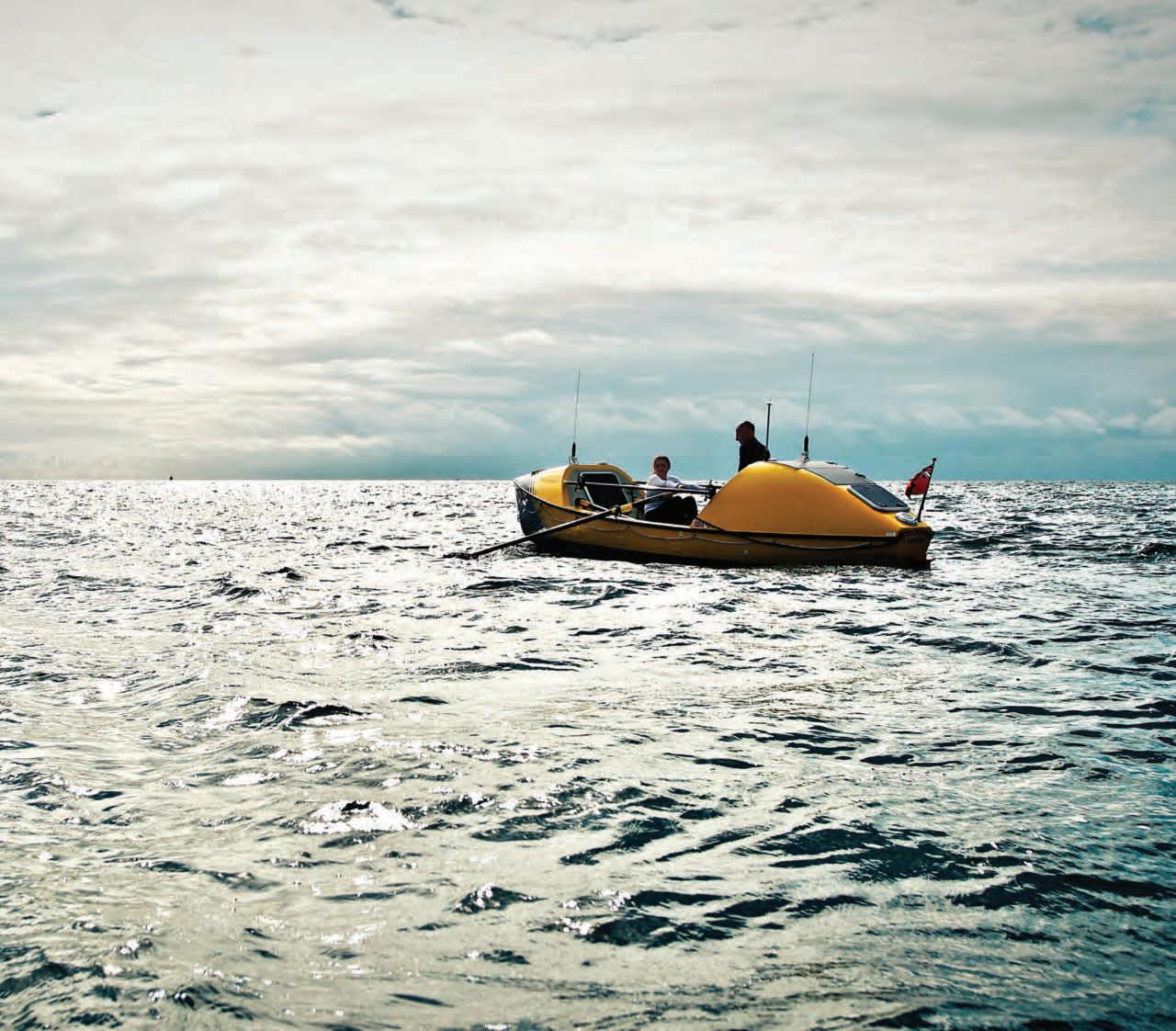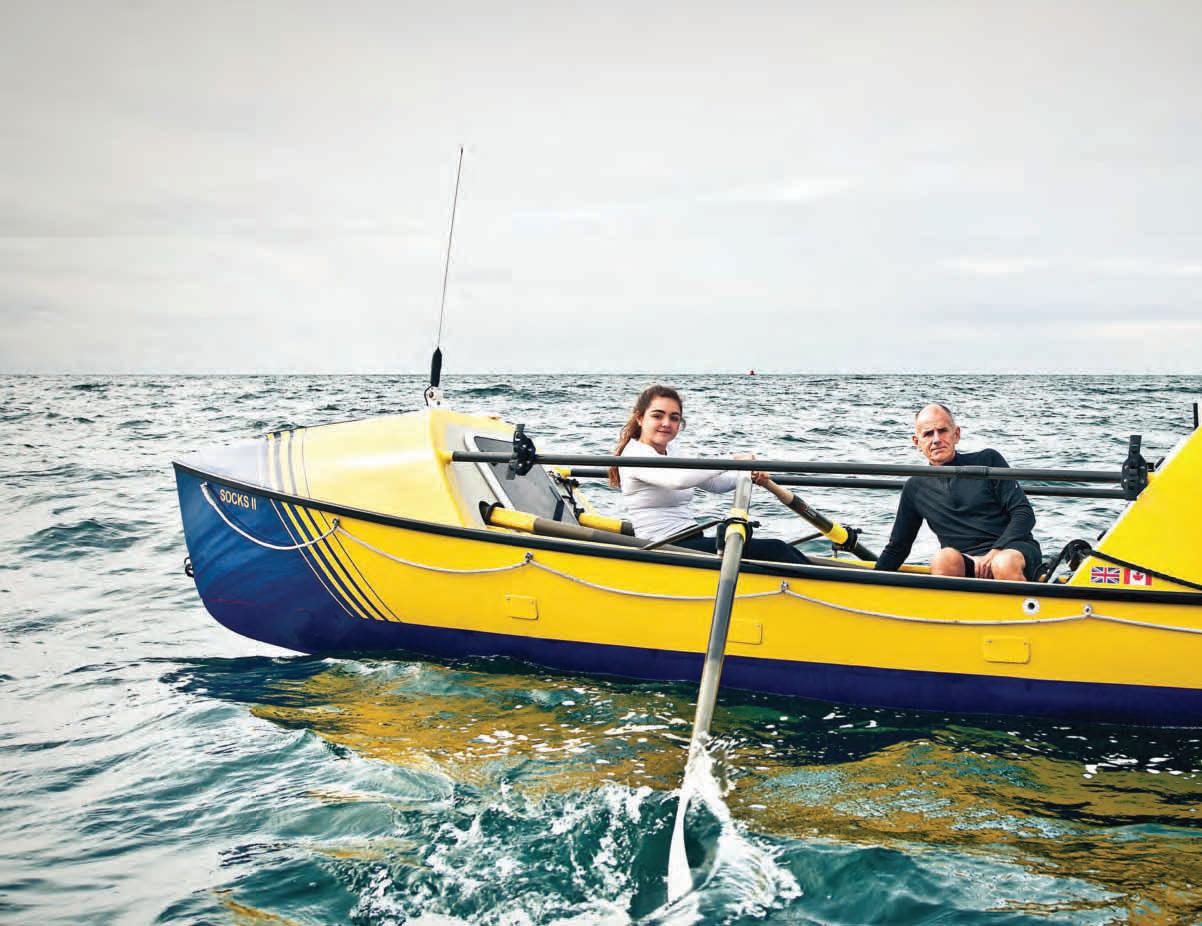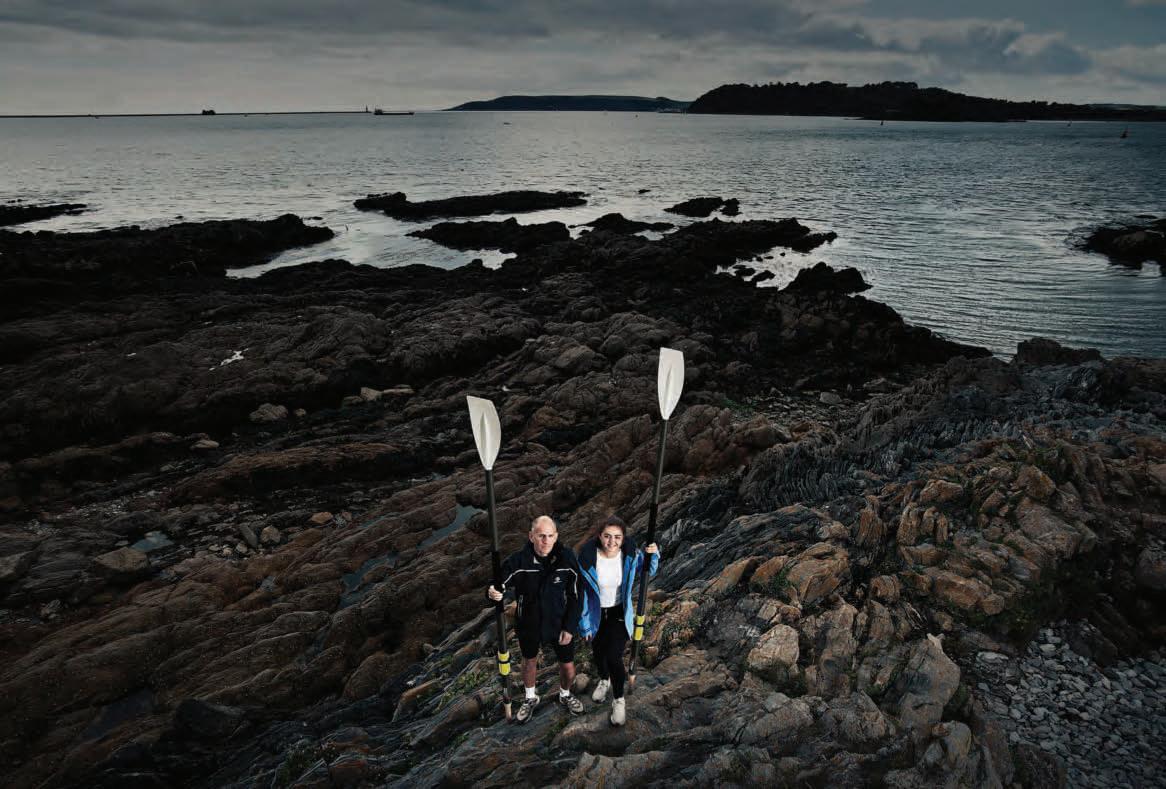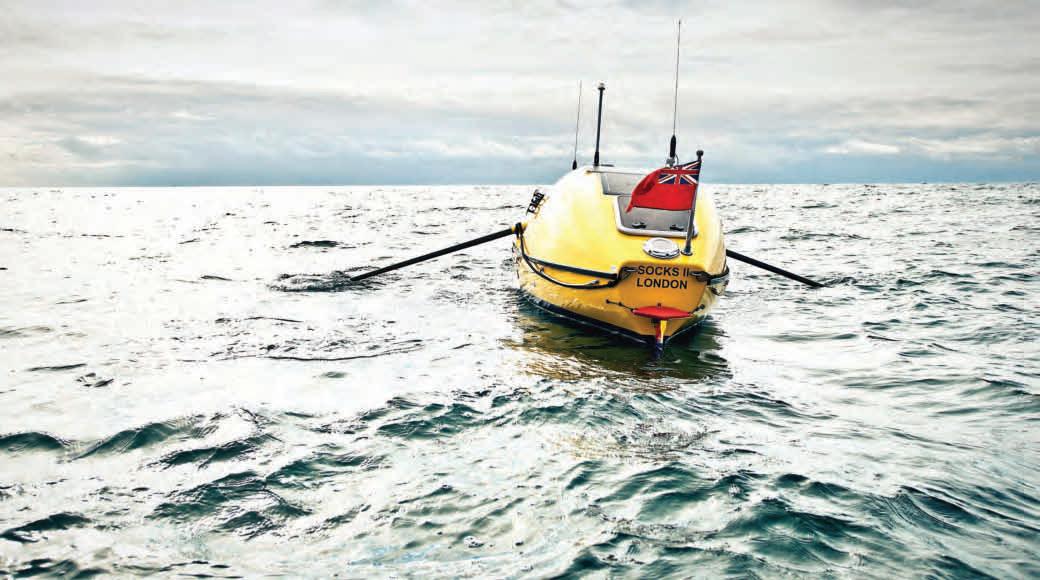
8 minute read
True Grit
TRUE
Libby Beeden ’16 rowed across the Atlantic with her father amid daunting hardships
14 | HSCREVIEW By Patricia Hluchy Portraits by Nick Bowring GRI
Photo by T
ine days into Libby Beeden’s epic three-month row across the Atlantic with her father, their boat nearly capsized. “It was our first bad weather day and nothing dramatic had happened so far, so I thought, ‘It’s not so bad,’” recalls Libby ’16. “The waves were 15 or 20 feet high but nothing had killed us so far.

“WE’RE TIRED, WE’RE CHATTING, WE’RE NOT PAYING ATTENTION. All of a sudden, I hear Dad go, ‘Hold on!’ I look to the right and this wave just breaks on top of us. It was like we went under a waterfall for a minute. The boat went at least 70 degrees, maybe 90; we were hanging on by a thread. We locked eyes for a solid five seconds but it honestly felt like 10 minutes.”
They moved to one side of the boat to stop it from capsizing. Libby and her father, John, started the process of bailing out the boat. “Somehow we got through it,” she says, “but it was frightening as heck.”
They had started their crossing in the southern Portuguese coastal town of Portimão on Nov. 30, 2018. The pair had planned to row all the way to Miami, but due to unusually difficult weather and currents, they ran low on supplies and chose to make land in the Caribbean. It was the third oceanic row for John, 58, who had soloed across the Atlantic in 2011 and the Pacific in 2015, but the first such expedition for Libby, now 21. And while she contends that the idea for the trip was mutual, John insists it was Libby’s. “I wasn’t interested in going anywhere near a boat after the Pacific row,” says John, a long-time runner who, with his wife Cheryl, spent 26 years managing a consumer exhibition connected to the London Marathon. “And after I’d actually sold the boat, Libby said something about a pairs crossing of the Atlantic.” John ended up buying back the boat and refitting it so that it could accommodate two people.
As a teenager, Libby had already revealed the grit beneath her pixieish, five-foot-two

exterior. When she was around 14 and on the HSC rowing team—she pursued the sport in Grades 9 through 11—she went out for dinner with her family one Sunday evening. At 2 a.m. she woke up with terrible food poisoning. But Libby was adamant that her mother drive her to rowing practice at 4.30 a.m., and then was sick in the car on the way. “I honestly never missed a single day,” says Libby, who would get herself up at that time for the three practices a week during the fall/winter season and five days a week from March until the end of the school year. “That’s me: if I’m committed to something, I’m not going to give it anything less than 100 per cent.” Her U.K.-born father, who now lives in Town of the Blue Mountains, Ont., says Libby comes by her self-discipline “organically. Our family [which also includes elder daughter Georgina ’15] has always been involved in athletics, and I guess Libby inherited the kind of work ethic that you need to succeed.”
Libby is now giving her all as a first-year mathematics student at the University of Sussex in England, despite having lacked a passion for math in high school. A music lover who plays piano and guitar, she made two earlier stabs at postsecondary education, enrolling in music-business programs in London and withdrawing because they weren’t demanding enough. She says she’s found the challenge she was looking for at Sussex. “I’m in the library studying from, say,
ATLANTIC OCEAN
St John’s, Antigua and Barbuda
SOUTH AMERICA
Portimão, Portugal
AFRICA
Completed route totalled 6,458 km (3,487 nautical miles)
7 in the morning until 7 at night. The only breaks I have are lectures and lessons, or when I go to the gym. I study all weekend. I’m not putting anything less than my full effort in it. That way I know that if I get a bad result, at least I tried my best.”
Libby brought that fierce commitment to the Atlantic trip. Her close friend Laura Kain ’16, whom she met at HSC, recalls visiting Libby in London the summer before the row. “She got up hours before I did every day,” Kain says, “just so she could go to the gym twice a day every day to build up her strength for the row. I’ve never seen someone at our age have so much commitment and courage.”
The boat Libby and her father used, Socks II, is a specially designed, sixmetre ocean rowing vessel. It contains six deck lockers, used mainly for food— their diet consisted largely of dehydrated food, dried fruit, nuts and cookies. It has a forward stowage compartment and a six-foot-long rear cabin for sleeping or taking shelter from the elements—it was a very tight fit for two—as well as for storage of navigation and communication equipment.
The boat was fitted with three solar panels to power all their electronic equipment, plus a desalinator for drinking water. And among other things it carried “spare parts, an extensive first aid kit, tools, basic entertainment, six oars, spare clothing, gas for boiling water to cook, 25 bottles of sun screen, 54 rolls of toilet paper, washing and cleaning supplies, and even a few small Christmas presents,” says John. “Basically we were sleeping with food rattling around the cabin for the first month.”
A bucket served as a toilet; usually when one person was using it, the other went into the cabin. “We had to row with our eyes closed while the other washed each night,” John chuckles.
The trip started inauspiciously. “In the first 12 hours we were out there, I threw up 11 times,” Libby recalls. “I didn’t think I’d get through those five days—I couldn’t eat anything but still had to row 12 hours each day. Seasickness is bad enough if you get to go home at the end of the day, but if you don’t get to go home, it’s horrendous. Eventually, on Day 5, I ate half a ginger biscuit.”
Soon after her recovery, the near-capsizing occurred. Then more hardship followed. The current was against them as they approached the Canary Islands. “Honestly, every single day felt like we were rowing into cement,” Libby says. They expected that once they got through the islands they would be buffeted by the Trade Winds and a reversal in the current. Neither happened. “The current was either not there or it was going back towards Africa,” says Libby, “and then the wind would go around in circles all the time. It was utterly insane.”
Despite all that, John says proudly, Libby did her equal share of the rowing, for which they took turns. Because Libby found it frightening to row in the dark when the waves were big and she couldn’t see them, she skipped some of her night shifts, making up the time in the daylight and before and after dawn and sunset.



However, because of the strong prevailing current near the end of the trip, Libby had no choice but to row in the dark. “I swear the waves were 20 feet and coming from every direction,” she remembers. “A wave would land on your lap and you’d get soaked in the dark. It’s cold, you’re tired, it’s scary.”
But she did experience moments of grace on the crossing. There was the wildlife, including many dolphins and a pair of whales that seemed to accompany them for days. And there were nights of blissful rowing in relatively calm waters. “It’s so exciting because the stars are crazy; you see a shooting star every 30 seconds.”
After 91 days and 6,458 kilometres, they reached Antigua in the eastern Caribbean on March 1, 2019. Libby became, her father says, the youngest person ever to row the Atlantic as part of a pair, and the second youngest woman to row the ocean in any configuration. But she balks at the notion that the trip was an extraordinary achievement for her. “Don’t get me wrong—it was hard,” she says. “But if I could do it as a 20-year-old girl, anyone can do it.”
And now, a year after they finished, Libby is still mulling over how the trip changed her. She already had a lot of self-discipline, she says; being on the rowing team at HSC—her favourite part of high school—“cemented that in me.” Still, she allows that the row is probably helping her stay the course through a very challenging academic program.
SOCKSII
6.1m long
Built from close cell foam with a kevlar outer shell and fiberglass inner shell.
Six deck lockers, mainly for food storage.
Central wet lockers for the para anchor, ropes and drogues. Also for balast in bad weather.
A forward cabin for stowage.
An aft cabin for sleeping and all the electrical equipment.
The two cabins also form the main elements of the selfrighting design.
And since she returned to university, a big ambition has taken shape. Like her father, Libby is passionate about Formula One racing, to the point where she recently contacted Claire Williams, the deputy principal of the U.K.’s Williams Formula One racing team. Libby hoped to meet her and perhaps angle for an internship. “She’s inspirational to me,” says Libby, whose “dream job” is motor sports strategist.
“It’s a very strategic sport: you obviously win if you have the best car, but you can make up places in the strategy. It’s the same reason why I like American football rather than soccer—it’s more strategic. F1 is more than sport; it’s a bit of a mental game.”
Libby is clearly ready for it—she has already mastered the mental game of sticking with something you’re committed to despite daunting obstacles.





